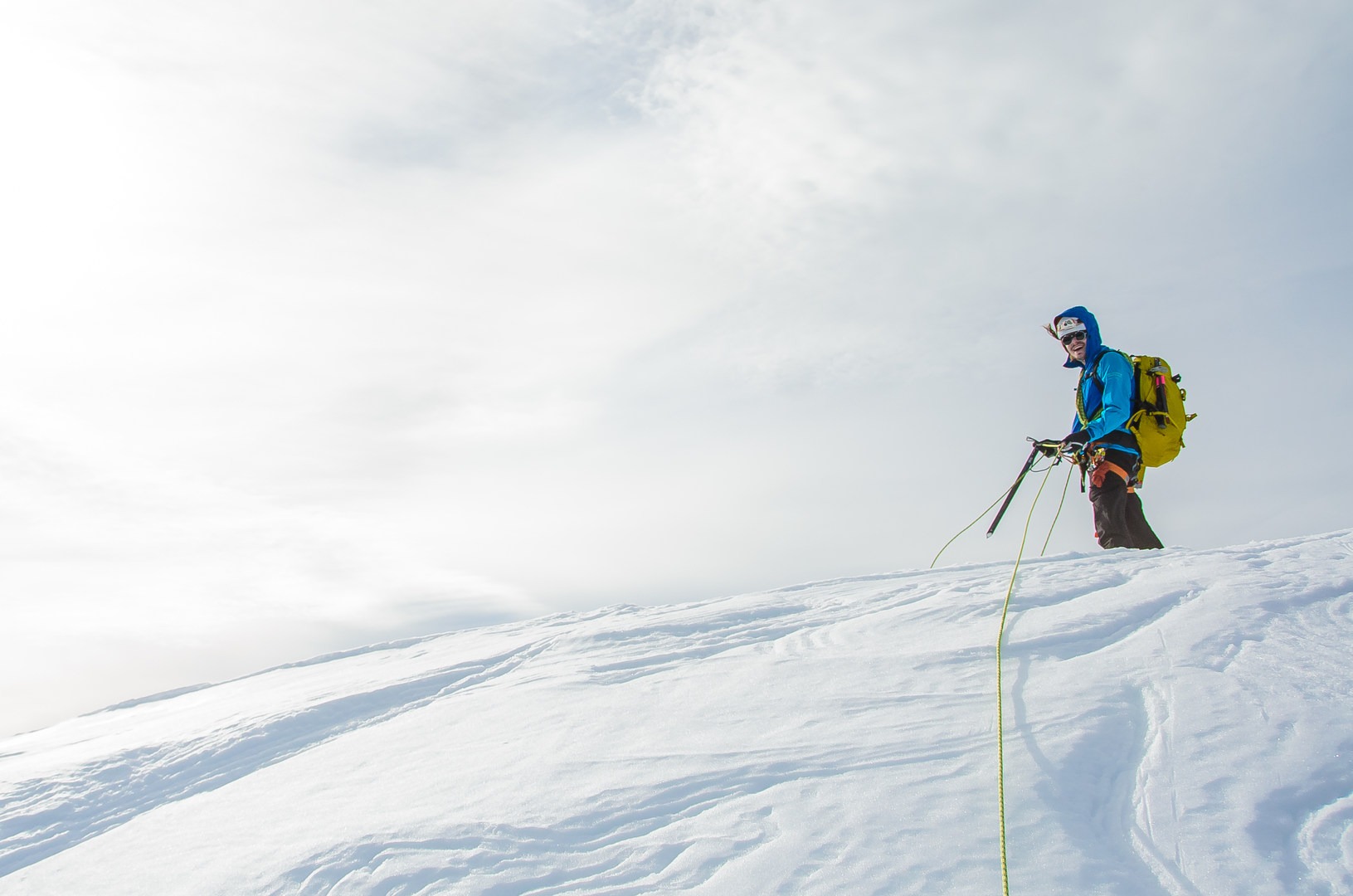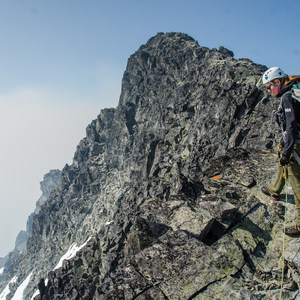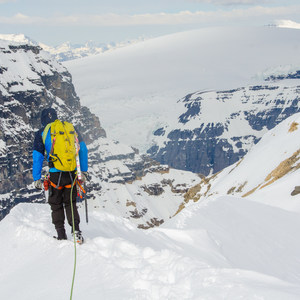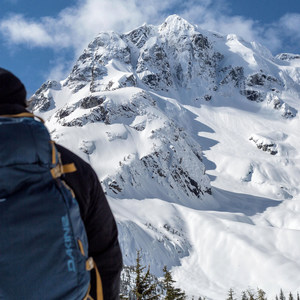You are here
A lot of people have been asking me about mountaineering recently, whether the question is a general "How do I get into mountaineering?" or a more specific "I want to get into glaciers, but how dangerous are they?" Given the abundance of social media posts that advertise people's passions, more and more people are keen to push their adventure beyond the trails. So what is the best approach for improving your mountain game?
Step 1: Getting into the outdoors
Chances are you're probably well on your way to being a competent outdoors person. You've stood on top of a couple of peaks. You check your routes carefully before going. You know how to develop an emergency plan, can read a topo map, and you’re pretty good about bringing most of the Ten Essentials with you. So congrats, you're basically finished the first step.
Mountaineering is basically hiking in more awkward places, with more stuff, and more danger. So the first place to start if you want to get into mountaineering is hiking and backpacking. Nothing will introduce you to mountaineering like trudging for hours on end with a heavy pack. It builds your tolerance for discomfort and reinforces the sense of suffering for a greater end. Camping and backpacking skills are equally beneficial in mountaineering, and being habituated to the cadence of tent life and away from any kind of convenience is really useful. Cooking, cleaning, sleeping, and other mundane tasks can be tough to acclimatize to if you aren't used to them, and trying to learn these tasks and mountaineering skills at the same time is very overwhelming. Start with the basics first.
Scrambling, a common extension of hiking, is a good final step before mountaineering. Hiking steep routes to summits builds comfort reading maps, planning routes, working your way across steep ledges, and hiking longer days. But most importantly, you'll start to learn route finding. This is the bread and butter of mountaineering, and the more comfortable you are picking out tricky routes in seas of gray rock, the easier it will be to locate routes through rolling mounds of ice.
How will you know when you are ready for the next step? Here is a good list of experiences you should have under your belt. You'll know you are ready to move on when you've...
- walked with a big pack for more than eight hours.
- had a day where everything seemed to go wrong.
- gotten lost.
- gotten soaked.
- gotten cold.
- experienced rapidly changing alpine weather above treeline.
- scrambled several peaks where you had to use your hands and crossed sections where a fall would have been catastrophic.
- done at least two backpacking trips longer than a weekend.
- learned how to belay, either outside or in a climbing gym, and learned how to tie all the basic knots.
Step 2: Take a course
While there are hundreds of YouTube videos out there, and Freedom of the Hills is great, they can't provide on-the-spot feedback or critical personal experience to help you learn in context.
A week-long mountaineering course is the best way to gain new skills quickly. Certified guides are very adapt at effectively explaining exactly what you need to know and correcting the inevitable mistakes that everyone makes. You might be tempted to load up on all the cool gear first, but remember, knowledge is almost always a better investment than gear (more on this bellow).
So what skills should you be looking for? Here is a good list from Cloud Nine Guides:
- Safe travel and protection techniques for snow and ice terrain
- Ice ax technique, crampon technique, self-arrest technique, snow and ice anchors, skills for glacier travel, reading crevasses and glacier morphology, hazard identification in glaciated terrain, route plans for glaciated terrain, roping up for glacier travel, crevasse rescue, alpine ice climbing techniques
- Navigation, designing effective route plans, introduction to navigational tools including: GPS units, compass, altimeter, topographical maps, Google Earth, resections (Triangulation), bearings from the map, sighting bearings in the field, following a bearing while roped up for glacier travel, whiteout navigation plans
- Introduction to accident and emergency response
- Evacuation techniques and resources for rescue
- Safe travel and protection techniques for alpine rock terrain
- Short-roping principles, traditional rock protection strategies, rock and natural feature anchor construction, rappelling
- Systems, backups and other descent techniques
Can't afford an ACMG/AMGA/IFMGA course?
Many clubs are able to fill courses to max capacity and get a discount, or hire guides for shorter curriculums. Some, like the British Columbia Mountaineering Club, run very inexpensive courses that are run by volunteers. (This course is more dedicated to snow climbing and crevasse rescue with less emphasis on rock skills, but it has more hands on experience than many other courses thanks to it's multi week structure.)
One thing about courses though...they don't make you ready to climb mountains. They help you become significantly less of a liability when joining more experienced partners.
Step 3: Find partners
This is often the trickiest part. Having a course under your belt makes things a lot easier, as it demonstrates some level of competency. Clubs like the Alpine Club of Canada, the American Alpine Club, or the Sierra Club are plentiful. A quick Google search in your area should turn up some results. Having a course under your belt demonstrates a commitment to getting trained and that you have been presented with the skills required, making it much easier to join a trip.
Doing a course with friends is another great way to ensure you've got adventure buddies. But remember, courses just give you the skills to react. They don't give you the experience to know how to act. Where possible, try and find some more experienced people to go into the mountains with. You'll have a rich trove of stories and experiences to learn from.
So, how do you get mentors and partners?
- Join a club: A lot of people, a lot of knowledge, a lot of perspectives.
- Be enthusiastic: Watch Alex Honnold in Line Across The Sky. He is perpetually bringing good vibes to the team. Always bring the stoke, especially when it’s slipping. Many beginners are slow, and it can be a little tiresome taking them out. But if you are fun to be around and keep the moral up when its taking a nose dive… you’ll find that people will invite you a lot more.
- Be responsible: Do your research, know the route, don’t rely on others to do your camp chores or plan the route.
- Reach out: Feel free to ask people to do stuff. You will often hear a no, but ask anyway.
Step 4: Get the gear
Many people rush this step first. This step is intentionally the fourth step.
There are very few pieces of fancy mountaineering gear that you need. My first trip was wearing clothes that cost a total of $100 and an assortment of borrowed gear. Ignore the blog posts telling you the 10 items you NEED. Bad gear is normally partly influenced by bad attitudes. Remember that the first attempts at Everest were done wearing eight silk shirts, tweed jackets, and cravats.
Okay, so chances are by this stage you probably have pretty much everything you need already. Not borrowing gear and buying dirt-cheap crappy stuff is a great way to find out what things you really need.
There are only two things you NEED to invest your money in: knowledge and footwear.
Knowledge will be what allows you to access new places and wonderful new experiences. Gore-tex jackets, while awesome, only last three to eight years, and they marginally increase your comfort. You can adjust your attitude toward comfort for free. Knowledge in the mountains comes harder. And knowledge, well practiced, will last you a lifetime.
I can promise you, this is a lesson I learned from personal experience. Spending money on gear over knowledge just slows the process down, and it is a bad call in the the long run.
Most gear, you can rent, borrow, or do without. If you've found more experienced partners, chances are they are going to have communal gear like ropes, trad rack, and the like. Ice axes are the easiest item to borrow. They are rarely in use, sizing isn't really that important, and they all work basically the same with a couple very minute differences.
Start buying personal items that impact your comfort the most, as you can't easily acquire these. Mountaineering boots, harnesses, and a full layering system are the hardest items to borrow. Boots and clothes can often be bought used. If you can't afford new gear, the MEC Gearswap is great for reliable used kit, and there is always Craigslist.
But everyone likes lists. So here is what you should invest in (in order):
- Non-Cotton layering system (try the sports sections at thrift stores sports section if you're low on dough)
- Hiking boots
- Merino wool socks
- Pack
- Gaiters
- Climbing Harness
- Helmet
- More merino socks
- Mountaineering boots
- Course tuition
- Fancy insulation/waterproofs
- Crampons
- Ice ax
Step 5: Get out there and practice your skills
You've done a course! You've climbed a mountain! You can go do anything now!!!!
Well not quite. Mountains change all the time, and the art of mountaineering is interpreting those changes. For the first while you are going to face lots of new and potentially dangerous terrain. Mountaineering is about conditions, and it takes a lot of trips with experienced people to get a good sense of how to predict them. Now it's time to get out, have fun, and create experiences of your own. Spend time following other more experienced people. Build your experience. Hire a guide to further expand your skill set, or go after objectives that might be beyond your skill set.
It's also important to practice your skills. Set up crevasse rescue haul systems in your basement. Find a snowy hill and hone your ice ax arrests. It's easy to forget these skills because most people will (hopefully) never need to use rescue skills. But it's important to keep practicing to make sure that if you ever do need to use them, you can act without hesitation.








Comments
Sign In and share them.